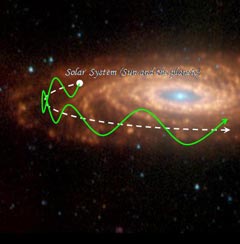What changes are needed to move from an aquatic existence to one on dry land? According to David Attenborough, a watertight skin, eggs with a hard shell, and stronger skeletal support to combat gravity. The differences between an amphibian’s egg and a tortoise’s egg also go more than shell deep: the embryo has to excrete waste, which in the water is naturally dispersed through the (permeable) egg membrane. On land, embryos instead develop an allantois (from the Greek word for “sausage”), which not only stores waste, but also permits the embryos to breathe. They need oxygen, and again in the water this would occur naturally through the membrane — but with a shell, that’s not possible. The allantois, however, presses against the shell strongly enough to exchange gas, and the embryo is connected to the allantois with blood vessels to treat it somewhat like a lung. Wow.
According to the wikipedia entry, human fetuses also have an allantois, which is inside the umbilical cord!
Darwin was first inspired about natural selection when observing the strikingly different tortoise shell shapes observed in the Galapagos Islands — distinct enough that a tortoise’s home island could be immediately inferred from its shell (well, or its taste):
The inhabitants, as I have said, state that they can distinguish the tortoises from the different islands; and that they differ not only in size, but in other characters. Captain Porter has described those from Charles and from the nearest island to it, namely, Hood Island, as having their shells in front thick and turned up like a Spanish saddle, whilst the tortoises from James Island are rounder, blacker, and have a better taste when cooked. — Charles Darwin, Journal of Researches, 1845, p. 394
Unfortunately, he didn’t record carefully enough which island each of his specimens came from, so on his return to England he instead used the less dramatic finch-beak example to illustrate his theory. He himself knew almost nothing about birds; his servant Covington collected the finches, and John Gould back in England identified and catalogued them. It’s useful to have smart, industrious friends (and servants)!
Tortoises live mostly on the land, while turtles live in the water. You can immediately see the differences; tortoises have short stumpy legs, for walking, while turtles have flipper/paddle limbs for swimming. It’s the turtles’ bad luck that they still have to struggle out of water up onto land to lay their eggs when they breed — no mean feat!
Attenborough’s book next has a chapter on crocodiles (lower teeth are visible when the mouth is closed) and alligators (lower teeth are invisible when the mouth is closed). Apparently their teeth are good for gripping prey, but not sharp enough to cut it into bites, so they rip by spinning their bodies around the (dead) prey, then have to rise up above the water to swallow the meat, because they “have no lips” to keep water out of their stomachs if they swallow. It’s amazing they ever get anything eaten.
Finally, crocodiles have very long courtship and mating processes, which often involve blowing bubbles at each other to indicate interest.
What a great book! Next up are the lizards, my favorite.
(Other things I learned from “Life in Cold Blood” by David Attenborough: Amphibians and their alien adaptations)

 The discovery of
The discovery of  But maybe our own location isn’t always so habitable, either. It’s been observed that if you plot the number of extant species as a function of time on Earth (a biodiversity curve), there is a certain cyclicity to the peaks and troughs. Fourier analysis identifies frequencies that have a strong correlation with the signal. It was previously thought that there was a 26-27 Myr periodicity, but this is now viewed as an artifact of the sampling rate (through time) of the curve. After the recent revision of the geological time scale, a stronger signal is found with a period of 62 Myr. So, what might be happening to cause biodiversity to peak and fall every 62 Myr? There are a lot of ideas, including the Nemesis theory of a companion star repeatedly passing through and disrupting the solar system, a sharp increase in the number of mantle plumes in the Earth, solar nuclear oscillations, and, intriguingly,
But maybe our own location isn’t always so habitable, either. It’s been observed that if you plot the number of extant species as a function of time on Earth (a biodiversity curve), there is a certain cyclicity to the peaks and troughs. Fourier analysis identifies frequencies that have a strong correlation with the signal. It was previously thought that there was a 26-27 Myr periodicity, but this is now viewed as an artifact of the sampling rate (through time) of the curve. After the recent revision of the geological time scale, a stronger signal is found with a period of 62 Myr. So, what might be happening to cause biodiversity to peak and fall every 62 Myr? There are a lot of ideas, including the Nemesis theory of a companion star repeatedly passing through and disrupting the solar system, a sharp increase in the number of mantle plumes in the Earth, solar nuclear oscillations, and, intriguingly,